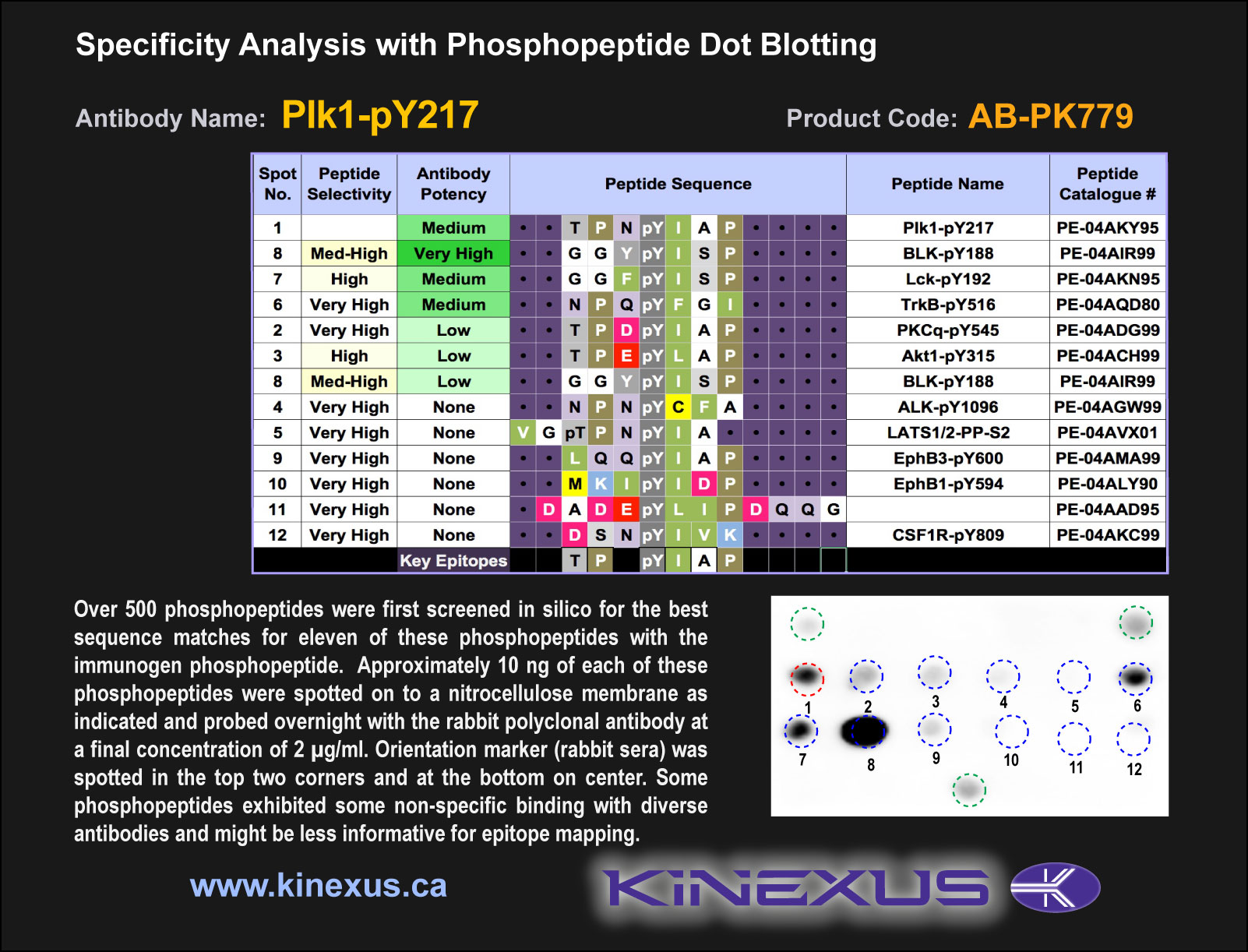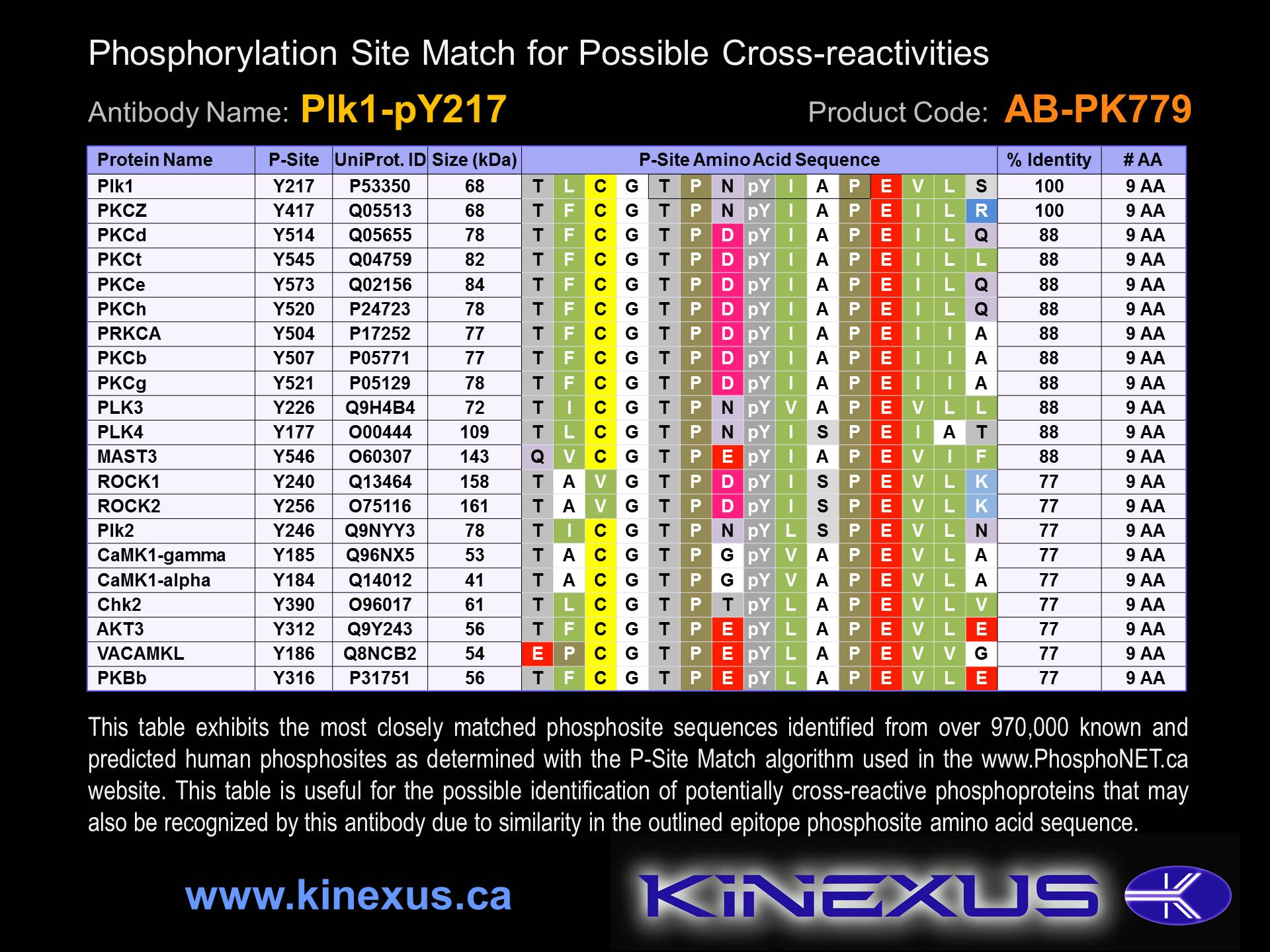Product Name: Plk1-pY217
Product Number: AB-PK779
| Size: | 25 µg | Price: | 89.00 | |
| $US |
Target Full Name: Polo-like protein-serine kinase 1
Target Alias: ADRB2; Kinase Plk1; Plk; Plk-1; Polo-like kinase 1; Serine- threonine protein kinase 13; STPK13; CCDS10616; ENSG00000166851
Product Type Specific: Protein kinase phosphosite-specific antibody
Antibody Code: PK779
Antibody Target Type: Phosphosite-specific
Antibody Phosphosite: Y217
Protein UniProt: P53350
Protein SigNET: P53350
Antibody Type: Polyclonal
Antibody Host Species: Rabbit
Target Alias: ADRB2; Kinase Plk1; Plk; Plk-1; Polo-like kinase 1; Serine- threonine protein kinase 13; STPK13; CCDS10616; ENSG00000166851
Product Type Specific: Protein kinase phosphosite-specific antibody
Antibody Code: PK779
Antibody Target Type: Phosphosite-specific
Antibody Phosphosite: Y217
Protein UniProt: P53350
Protein SigNET: P53350
Antibody Type: Polyclonal
Antibody Host Species: Rabbit
Antibody Immunogen Source: Human Plk1 (Plk) sequence peptide Cat. No.: PE-04AKY95
Antibody Immunogen Sequence: TPN(pY)IAP(bA)C
Antibody Immunogen Description: Corresponds to amino acid residues T214 to P220; In the protein kinase catalytic domain activation T loop region between subdomains VII and VIII.
Antibody Immunogen Sequence: TPN(pY)IAP(bA)C
Antibody Immunogen Description: Corresponds to amino acid residues T214 to P220; In the protein kinase catalytic domain activation T loop region between subdomains VII and VIII.
Production Method: The immunizing peptide was produced by solid phase synthesis on a multipep peptide synthesizer and purified by reverse-phase hplc chromatography. Purity was assessed by analytical hplc and the amino acid sequence confirmed by mass spectrometry analysis. This peptide was coupled to KLH prior to immunization into rabbits. New Zealand White rabbits were subcutaneously injected with KLH-coupled immunizing peptide every 4 weeks for 4 months. The sera from these animals was applied onto an agarose column to which the immunogen peptide was thio-linked. Antibody was eluted from the column with 0.1 M glycine, pH 2.5. Subsequently, the antibody solution was neutralized to pH 7.0 with saturated Tris.This antibody was also subject to negative purification over phosphotyrosine-agarose.
Antibody Modification: Unconjugated. Contact KInexus if you are interest in having the antibody biotinylated or coupled with fluorescent dyes.
Antibody Modification: Unconjugated. Contact KInexus if you are interest in having the antibody biotinylated or coupled with fluorescent dyes.
Antibody Concentration: 0.75 mg/ml
Storage Buffer: Phosphate buffered saline pH 7.4, 0.05% Thimerasol
Storage Conditions: For long term storage, keep frozen at -40°C or lower. Stock solution can be kept at +4°C for more than 3 months. Avoid repeated freeze-thaw cycles.
Product Use: Western blotting | Antibody microarray
Antibody Dilution Recommended: 2 µg/ml for immunoblotting
Antibody Species Reactivity: Human
Antibody Positive Control: The observed molecular mass of the processed target protein on SDS-PAGE gels is reported to be around 63-68 kDa.
Related Product 1: Plk1-pY217 blocking peptide
Storage Buffer: Phosphate buffered saline pH 7.4, 0.05% Thimerasol
Storage Conditions: For long term storage, keep frozen at -40°C or lower. Stock solution can be kept at +4°C for more than 3 months. Avoid repeated freeze-thaw cycles.
Product Use: Western blotting | Antibody microarray
Antibody Dilution Recommended: 2 µg/ml for immunoblotting
Antibody Species Reactivity: Human
Antibody Positive Control: The observed molecular mass of the processed target protein on SDS-PAGE gels is reported to be around 63-68 kDa.
Related Product 1: Plk1-pY217 blocking peptide
Related Product 2: Plk1-BKCD pan-specific antibody (Cat. No.: AB-NK145-2)
Related Product 3: Plk1-pT210 phosphosite-specific antibody (Cat. No.: AB-PK778)
Related Product 4: Plk1Subtide - Plk1 (Plk) protein kinase substrate peptide
Related Product 3: Plk1-pT210 phosphosite-specific antibody (Cat. No.: AB-PK778)
Related Product 4: Plk1Subtide - Plk1 (Plk) protein kinase substrate peptide
Scientific Background: Plk1 is one of several protein kinases that can phosphorylate KinSub1RPKSF. Human Plk1 is a protein-serine/threonine kinase of 603 amino acid length, with a predicted molecular mass of 68,255 Da. It is a member of the Other group of protein kinases in the Plk family. This kinase shows high variability in human tissue distribution with the highest levels detected in colon, kidney, pancreas and testes, and is notably absent in brain and spinal cord. Orthologues of Plk1 are amongst the most highly conserved protein kinases in animals, plants, fungi and unicellular eukaryotes. Plk1 is activated by phosphorylation at S49, S137, T210, and S326. Plk1 localizes to centrosomes or spindle pole bodies and undergo dramatic subcellular relocation during the cell cycle. Deregulated activities of Plk's often result in abnormalities in centrosome duplication, maturation, and/or microtubule dynamics (1). Plk's also regulate the function of the Golgi complex. Deregulated expression of human Plk1 is strongly correlated with the development of many types of malignancies, and ectopic expression of Plk1 dominant negative protein leads to rapid cell death (2). Plk1 has been linked with the development of colon and prostate cancers and lung squamous cell carcinomas (LSCC).
Figure 1. Epitope mapping of Plk1-pY217 antibody with similar phosphopeptides on dot blots.
Figure 2. Identification of phosphosites related to Plk1-pY217.
© Kinexus Bioinformatics Corporation 2017



